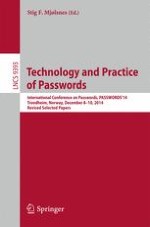2015 | OriginalPaper | Chapter
Password-Manager Friendly (PMF): Semantic Annotations to Improve the Effectiveness of Password Managers
Authors : Frank Stajano, Max Spencer, Graeme Jenkinson, Quentin Stafford-Fraser
Published in: Technology and Practice of Passwords
Publisher: Springer International Publishing
Activate our intelligent search to find suitable subject content or patents.
Select sections of text to find matching patents with Artificial Intelligence. powered by
Select sections of text to find additional relevant content using AI-assisted search. powered by
